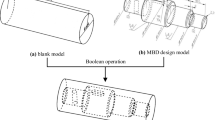Abstract
This paper presents a geometric reasoning approach for extracting the maximum turnable state (MTS) and its turning features for a mill/turn part which has multiple extreme faces. Here, an extreme face refers to a vertical planar face whose adjacent faces are all located on the same side of the plane. It is more difficult to construct the MTS for such a part because the positions of its cross-sectional planes do not change monotonically on the principal axis, and the concave regions formed by its profile need special treatments in its feature recognition. The proposed method addresses the issue of multiple extreme faces with a graph decomposition strategy for the attributed adjacency graph of CAD models, and handles the feature recognition problem by matching the feature shape descriptors with the descriptors of local element combinations out of the delta volume mesh. The method not only produces all the turning features for a part but also generates the feature precedence graph as well from reasoning on their adjacency relations. At the end of the paper, an example is presented to demonstrate the method’s effectiveness.
Similar content being viewed by others
References
Leo Kumar SP, Jerald J, Kumanan S (2014) An intelligent process planning system for micro turn-mill parts. Int J Prod Res 52(20):6052–6075
Givehchi M, Haghighi A, Wang L (2015) Generic machining process sequencing through a revised enriched machining feature concept. J Manuf Syst 37:564–575
Li RKW (1988) A part-feature recognition system for rotational parts. Int J Prod Res 26(9):1451–1475
Babic B, Nesic N, Miljkovic Z (2008) A review of automated feature recognition with rule-based pattern recognition. Comput Ind 59(4):321–337
Verma AK, Rajotia S (2010) A review of machining feature recognition methodologies. Int J Comput Integr Manuf 23(4):353–368
Zheng Y, Taib JM, Tap MM (2012) Decomposition of interacting machining features based on the reasoning on the design features. Int J Adv Manuf Technol 58(1):359–377
Ranjan R, Kumar N, Pandey RK, Tiwari MK (2005) Automatic recognition of machining features from a solid model using the 2D feature pattern. Int J Adv Manuf Technol 26(7):861–869
Madurai SS, Lin L (1992) Rule-based automatic part feature extraction and recognition from CAD data. Comput Ind Eng 22(1):49–62
Zhang Y, Luo X, Zhang B, Zhang S (2017) Semantic approach to the automatic recognition of machining features. Int J Adv Manuf Technol 89:417–437
Joshi S, Chang TC (1988) Graph-based heuristics for recognition of machined features from a 3D solid model. Comput Aided Des 20(2):58–66
Marefat M, Kashyap RL (1990) Geometric reasoning for recognition of three-dimensional object features. IEEE Trans Pattern Anal Mach Intell 12(10):949–965
Gao S, Shah JJ (1998) Automatic recognition of interacting machining features based on minimal condition subgraph. Comput Aided Des 30(9):727–739
Litter G, Clark DER, Corney JR, Tuttle JR (1998) Delta-volume decomposition for multi-sided components. Comput Aided Des 30(9):695–705
Woo Y, Sakurai H (2002) Recognition of maximal features by volume decomposition. Comput Aided Des 34(3):195–207
Yip-Hoi D, Dutta D, Huang Z (2003) A customizable machining feature extraction methodology for turned components. J Manuf Syst 22(2):82–98
Huang Z, Xie B, Ma L, Wei X (2006) Feature conversion based on decomposition and combination of swept volumes. Comput Aided Des 38(8):857–873
Jaider O, El Mesbahi A, Rechia A (2014) Manufacturing computer aided process planning for rotational parts. Part 2: a new approach for optimizing multiple interpretations of interacting features based on manufacturing rules and metal removal principals. Int J Innov Appl Stud 8(1):307–319
Sormaz DN, Khoshnevis B (2003) Generation of alternative process plans in integrated manufacturing systems. J Intell Manuf 14(6):509–526
Woo TC (1982) Feature extraction by volume decomposition. Conference on CAD/CAM technology in mechanical engineering, pp 76–94
Kim YS (1992) Recognition of form features using convex decomposition. Comput Aided Des 24(9):461–476
Kataraki PS, Mansor MSA (2017) Auto-recognition and generation of material removal volume for regular form surface and its volumetric features using volume decomposition method. Int J Adv Manuf Technol 90(5):1479–1506
Yip-Hoi D, Dutta D (1995) Data extraction from geometric models for process planning for parallel machines. J Manuf Syst 14(5):307–318
Waiyagan K, Bohez ELJ (2009) Intelligent feature based process planning for five-axis mill-turn parts. Comput Ind 60(5):296–316
Yip-Hoi D, Dutta D (1997) Finding the maximum turnable state for mill/turn parts. Comput Aided Des 29(12):879–894
Tseng YJ, Joshi SB (1998) Recognition of interacting rotational and prismatic machining features from 3-D mill-turn parts. Int J Prod Res 36(11):3147–3165
Watkins M, Rahmani K, D’Souza R (2007) Finding the maximal turning state of an arbitrary mesh. ASME 2007 international design engineering technical conferences and computers and information in engineering conference, American Society of Mechanical Engineers, pp 63–67
Li S, Shah JJ (2005) Recognition of interacting turning features for mill/turn parts. ASME 2005 international design engineering technical conferences and computers and information in engineering conference, American Society of Mechanical Engineers, pp 543–553
Li S, Shah JJ (2007) Recognition of user-defined turning features for mill/turn parts. J Comput Inf Sci Eng 7(3):225–235
Fu W, Eftekharian AA, Campbell MI, Kurtoglu T (2014) Automatic reasoning for defining lathe operations for mill-turn parts: a tolerance based approach. J Mech Des 136(12):121701
Kayacan MC, Filiz IH, Sönmez AI, Baykasoğlu A, Dereli T (1996) OPPS-ROT: an optimised process planning system for rotational parts. Comput Ind 32(2):181–195
Author information
Authors and Affiliations
Corresponding author
Rights and permissions
About this article
Cite this article
Liu, L., Huang, Z., Liu, W. et al. Extracting the turning volume and features for a mill/turn part with multiple extreme faces. Int J Adv Manuf Technol 94, 257–280 (2018). https://doi.org/10.1007/s00170-017-0862-4
Received:
Accepted:
Published:
Issue Date:
DOI: https://doi.org/10.1007/s00170-017-0862-4




